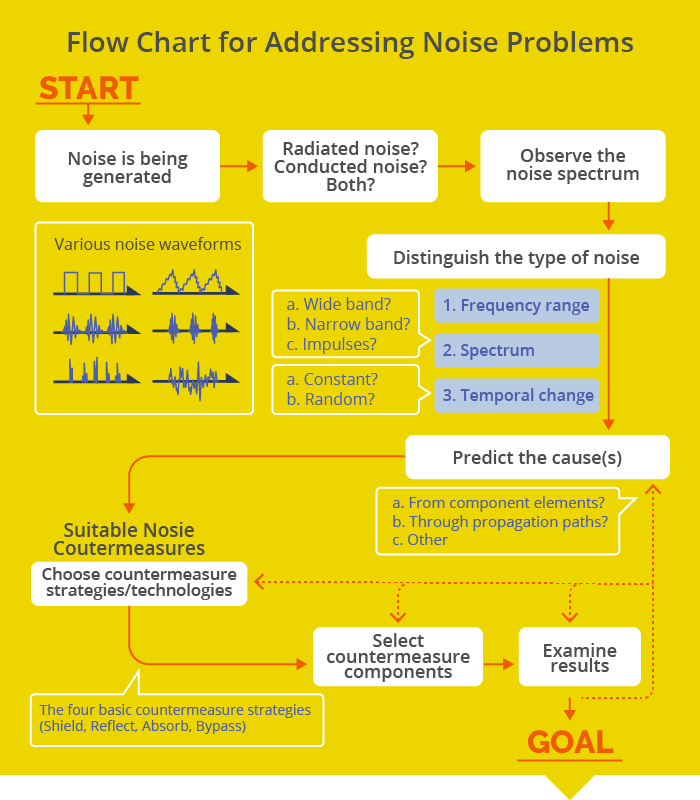Intro to EMC Topics
Practical Applications—Part 8: EMC Measures for Power Supplies

DC-DC converters are constantly fighting power loss and noise
Switching power supplies are predominant in IC-based electronic devices. Although compact, lightweight, and highly efficient, they generate noise and require thorough EMC measures. Additionally, the Point-of-Load (POL) model—where multiple DC-DC converters are distributed across the circuit board—has become prevalent in recent years, requiring passive components like power inductors to adopt new noise countermeasures.
AC current supplied from power outlets contains noise
Commercial AC (alternating current) supplied to homes, offices and factories from power plants via transmission lines and substations is not as stable as one might think. Every time one of many consumers turns power on or off, the voltage fluctuates. The waveform, which should theoretically be a sine wave, is distorted by noise and other factors. Substations constantly monitor the grid and correct waveform distortions with filters. These filters are based on the combined properties of a capacitor, which blocks DC but allows current to pass as the frequencies get higher, and of a coil, which allows DC to pass smoothly but impedes current as the frequencies increase. They are gigantic as they are designed for very high voltages and large currents, but they work under the same principle as LC filters used in electronic devices.
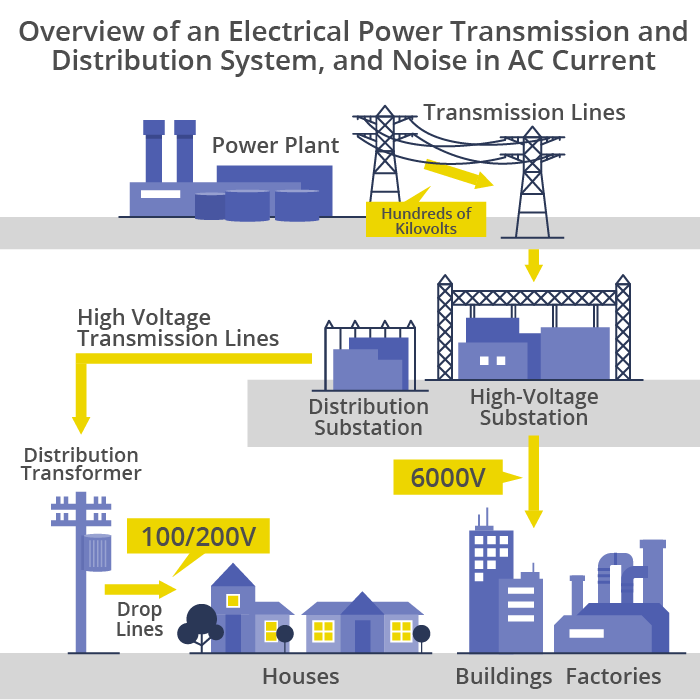
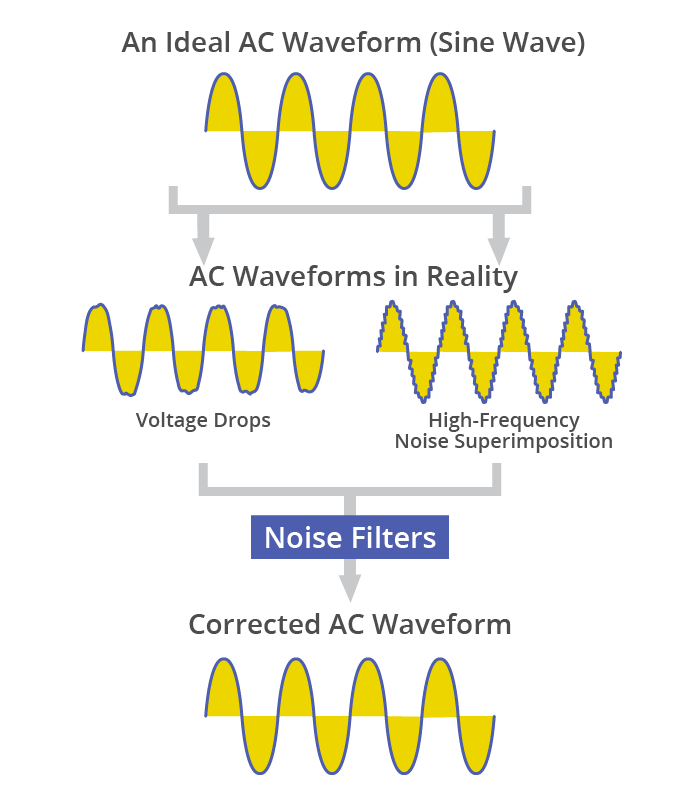
A slightly unstable AC current poses no problems for incandescent lamps and electric heaters. But for electrical and electronic devices that use ICs, noise introduced through the AC current can impair or even destroy ICs. This is why a noise filter is placed at the inlet of an AC power supply. For example, in a desktop PC, a small, socket-type noise filter is installed in the connector where the AC cord is plugged in (three terminals including ground) to remove noise superimposed on the commercial AC current before the power circuitry converts AC to DC. Mobile devices like notebook computers, on the other hand, draw DC power from their batteries. When sourcing power from an AC outlet, a notebook uses an AC adapter that converts AC to DC while simultaneously charging the battery. However, even if conducted noise in the AC power line is completely shut out, separate measures must be taken against noise generated inside the circuitry of electronic devices. Even though DC power lines are expected to provide stable current supplies, noises can infiltrate for various reasons. ICs are being driven by lower voltages and are handling larger currents and higher frequencies in recent years, requiring passive components in DC power supply lines to meet more stringent characteristics than ever before.
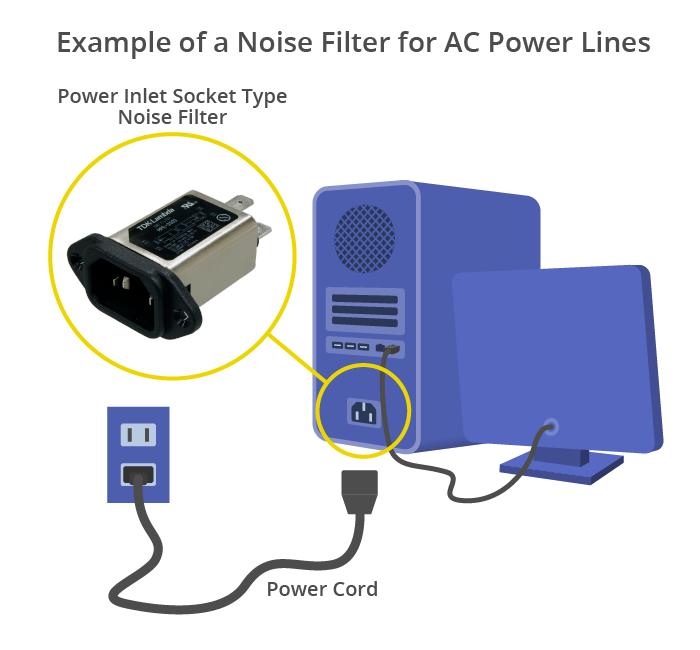
In electronic devices like PCs, noise filters are placed at the inlet of the AC power supply.
Two types of AC to DC conversion: the linear method and the switching method
Because electronic devices are powered by DC current, utilizing AC requires conversion. The conversion techniques can be broadly classified into the linear method and the switching method. The linear method uses a transformer to convert the AC voltage, then rectifies it to DC. The switching method converts AC to DC first, then converts the voltage using a high-frequency transformer switched by semiconductor devices. In the switching method, smaller transformers and other components will suffice, keeping the overall system compact and lightweight. Because it also features superior energy conversion efficiency, the switching method has become predominant in power supplies and AC adapters for electronic devices.
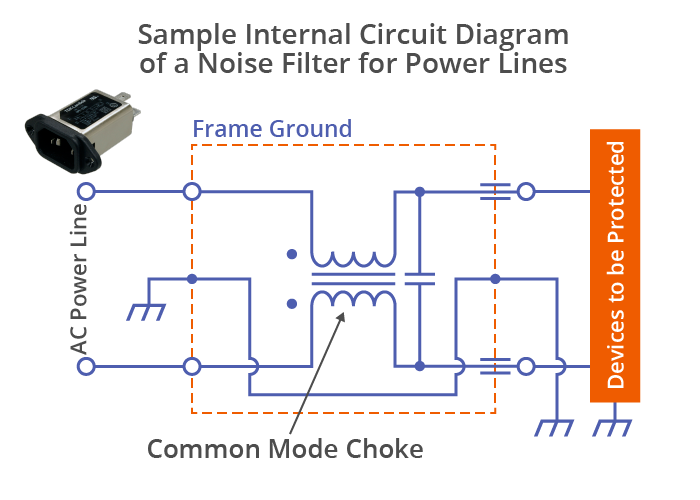
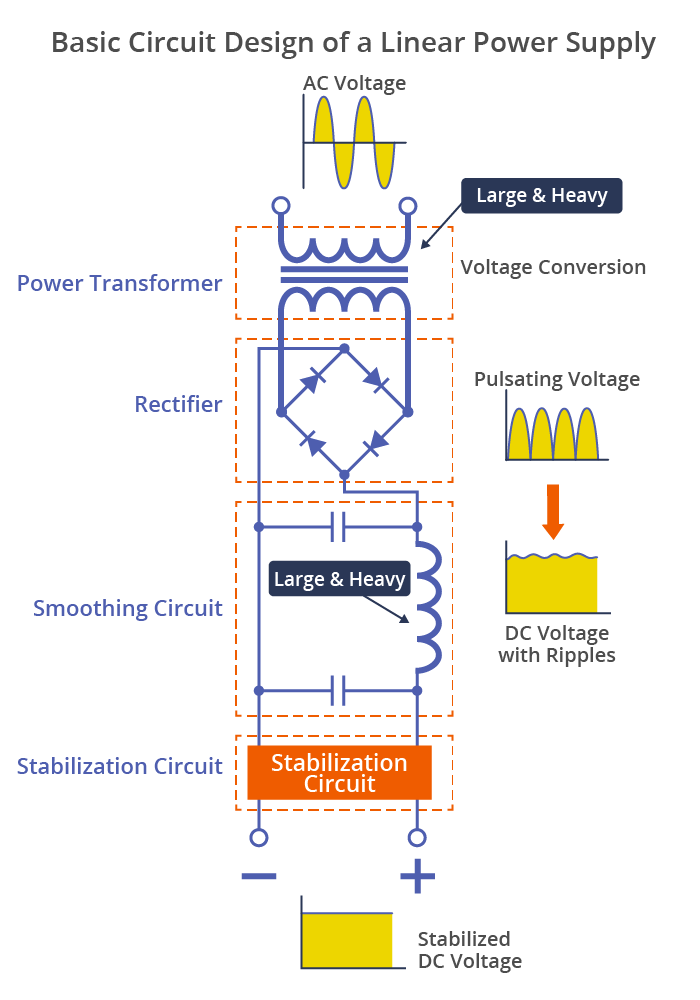

A simple AC adapter includes no stabilizing circuitry. They tend to be large and heavy because of the power transformer inside.
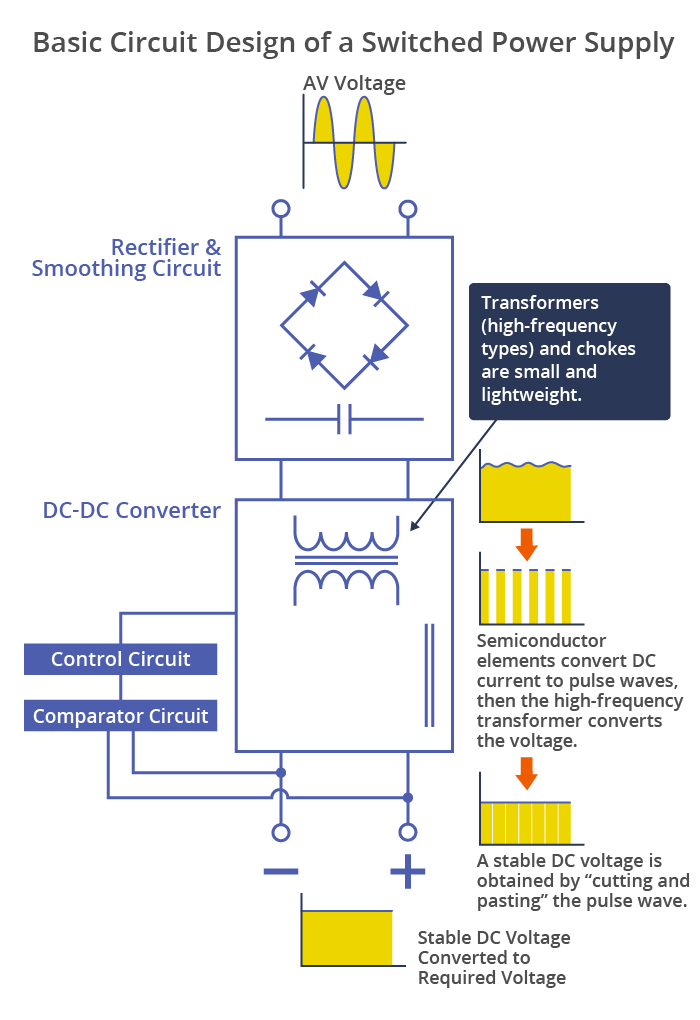
AC adapters for mobile phones and notebook computers use the switching method predominantly.
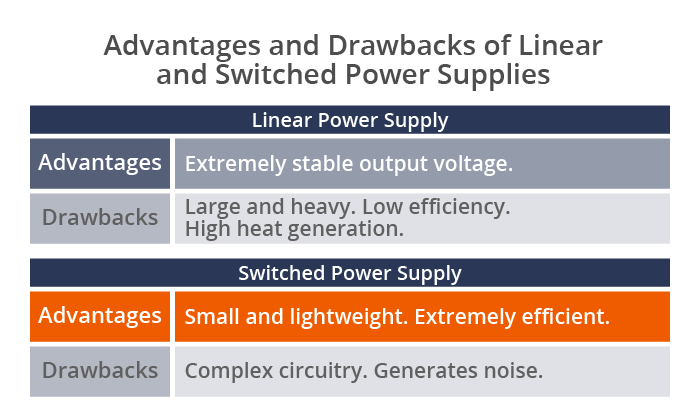
During transmission from electrical power plants, a considerable amount of power is lost as heat due to resistance in the lines. Similarly, power loss also occurs inside electronic devices in the routing of DC power lines. Particularly in mobile devices like notebook PCs and smartphones, reducing power loss is a priority because of the pressure to extend battery life. As a solution, there has been an ongoing trend to place dedicated DC-DC converters near each IC to supply the requisite voltages individually. This strategy of transitioning away from a conventional centralized power supply to a distributed model is called POL (Point-of-Load).
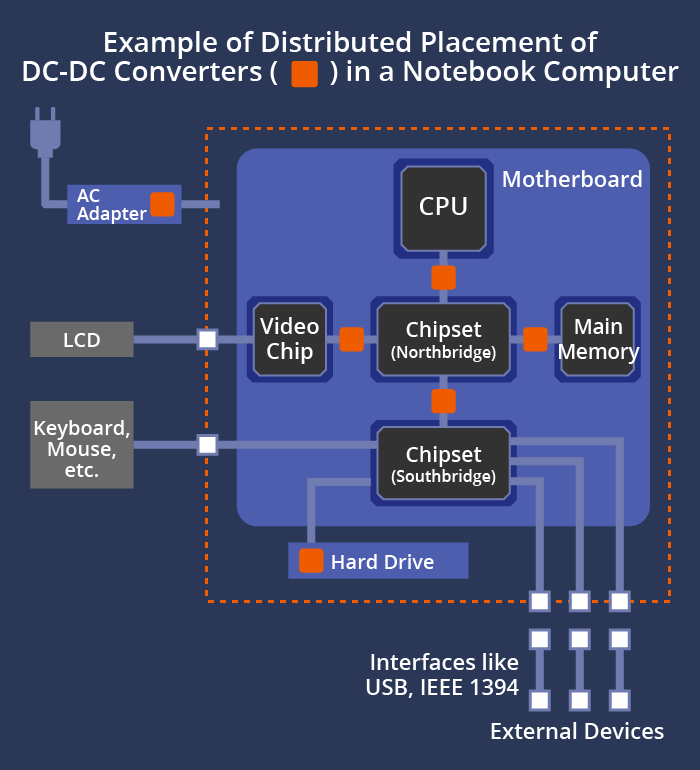
As DC-DC converters shift to POL, leakages of magnetic flux from power inductors become sources of noise.
A DC-DC converter based on the chopper method, which combines an inductor (coil), a capacitor and semiconductor elements (driver and control ICs), is commonly used as a POL power supply. The voltage of a DC current cannot be converted using a transformer. A chopper-based DC-DC converter power supply “chops” the DC current into small pieces and recombines them to provide a DC current with stable voltage.
Switching power supplies with AC inputs must meet certain noise standards, and EMC measures like common mode filters are typically used on the input side. DC-DC converters have yet to face any established noise standards, but as ICs are driven by lower voltages and handle larger currents, DC-DC converters turn larger currents on and off at higher frequencies, and the generation of high-frequency noise is becoming a growing problem.
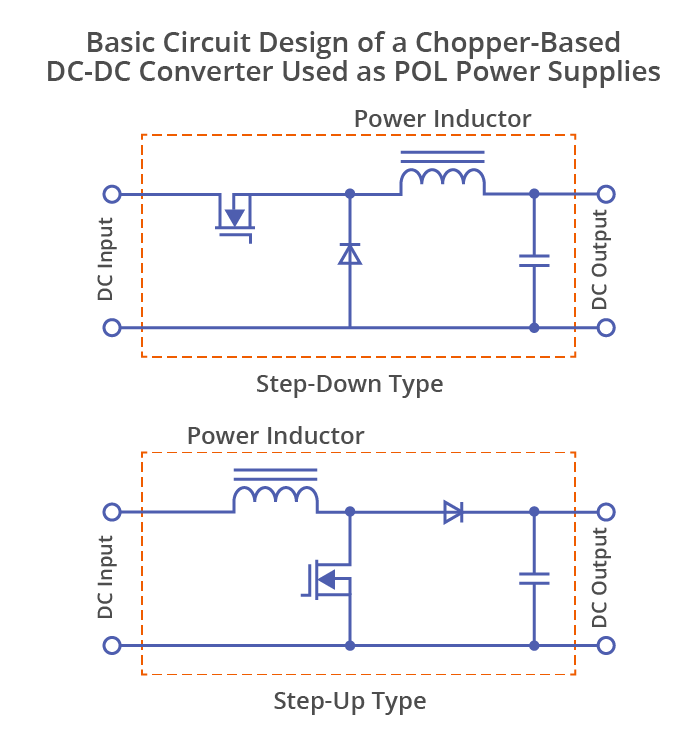
As ICs become driven by lower voltages and handle larger currents, DC-DC converters—which have no transformers and are based on the chopper method—are becoming used widely in POL power supplies for electronic devices.
Leakage of magnetic flux from power inductors cannot be overlooked in POL
Although DC-DC converters are compact, lightweight and highly efficient, they bear a fundamental weakness: the semiconductor elements’ switching action generates noise. To suppress noise, ferrite beads are inserted or filtering circuits are implemented on the output side, but conventional measures like these result in power loss and reduced efficiency, shortening battery life in mobile devices. This is where noise suppression components with minimal power loss, such as low-resistance chip beads (exemplified by TDK’s MPZ series), are useful. Using capacitors with superior high-frequency characteristics, shortening large-current wiring paths, and reducing magnetic flux leakage from power inductors are also effective.
Power inductors used in a DC-DC converter are made of wires wound around a magnetic core material. Generally, a gap is created in the magnetic flux’s path to prevent the core from becoming saturated by the magnetic field generated by the coil. However, the leakage of high-frequency magnetic flux from this gap causes a tricky problem: magnetic coupling with wiring and nearby components generates noise.
To address this problem, TDK has developed the VLM series of power inductors, which use a low core-loss, high-Bs (magnetic saturation flux density), manganese-zinc (Mn-Zn) ferrite core and a magnetically coupled structure with no gap on the outer surface. By combining a box-shaped and a cylindrical core, the gap is formed internally, which significantly reduces the leakage of magnetic flux and enables usage with large currents.
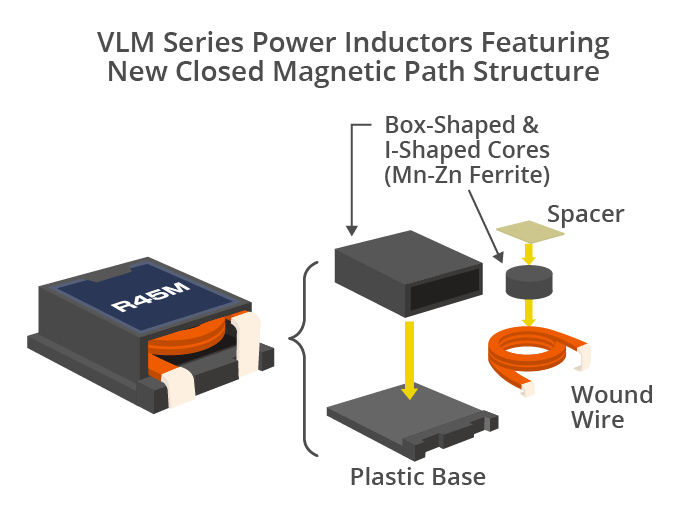
A new closed magnetic path structure that significantly reduces magnetic flux leakage
The SPM series of power inductors utilize metallic magnetic materials with higher magnetic saturation flux density than ferrite. Because metallic magnetic materials have low electrical resistance, overcurrent loss is usually large in the higher frequencies. The SPM series, however, features a pressure-molded dust core composed of a metallic magnetic powder that is coated with resin. Since the resin coating functions as gaps, the magnetic flux leakage is dispersed throughout, resulting in excellent characteristics. What’s more, the coils are integrally molded with the powder. The small size, low profile and excellent reliability make the SPM series advanced power inductors ideal for driving CPUs, power supplies for telecommunication base stations and other applications that require large-current capabilities.
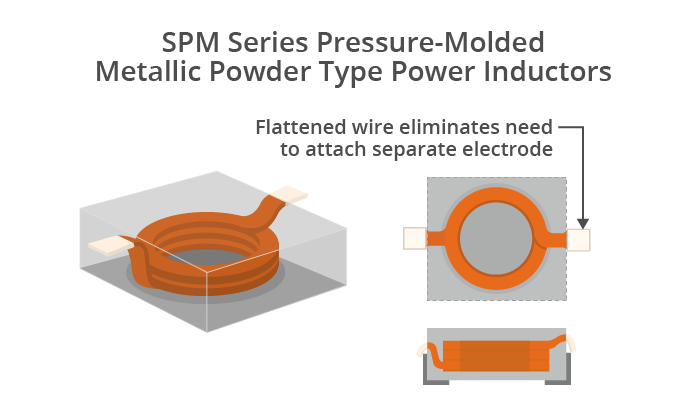
Integral molding of metal powder and coils
TDK offers an extensive line of wound-wire, multilayer, and thin-film power inductors. For more information, please refer to Inductors for Power Circuits Selection Guide at the TDK Product Center.
https://product.tdk.com/en/products/selectionguide/smd-commercial.html
TDK is a comprehensive electronic components manufacturer leading the world in magnetic technology



